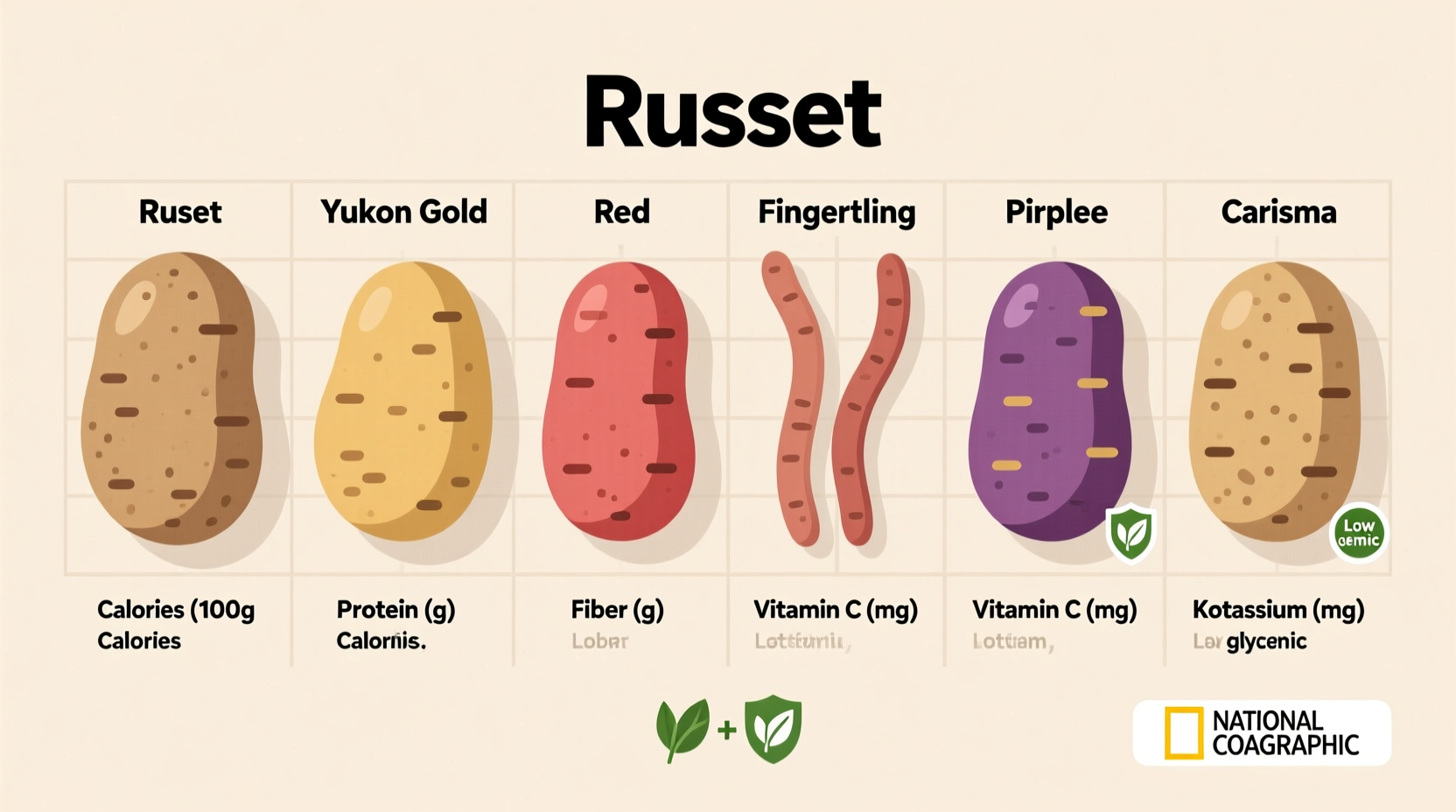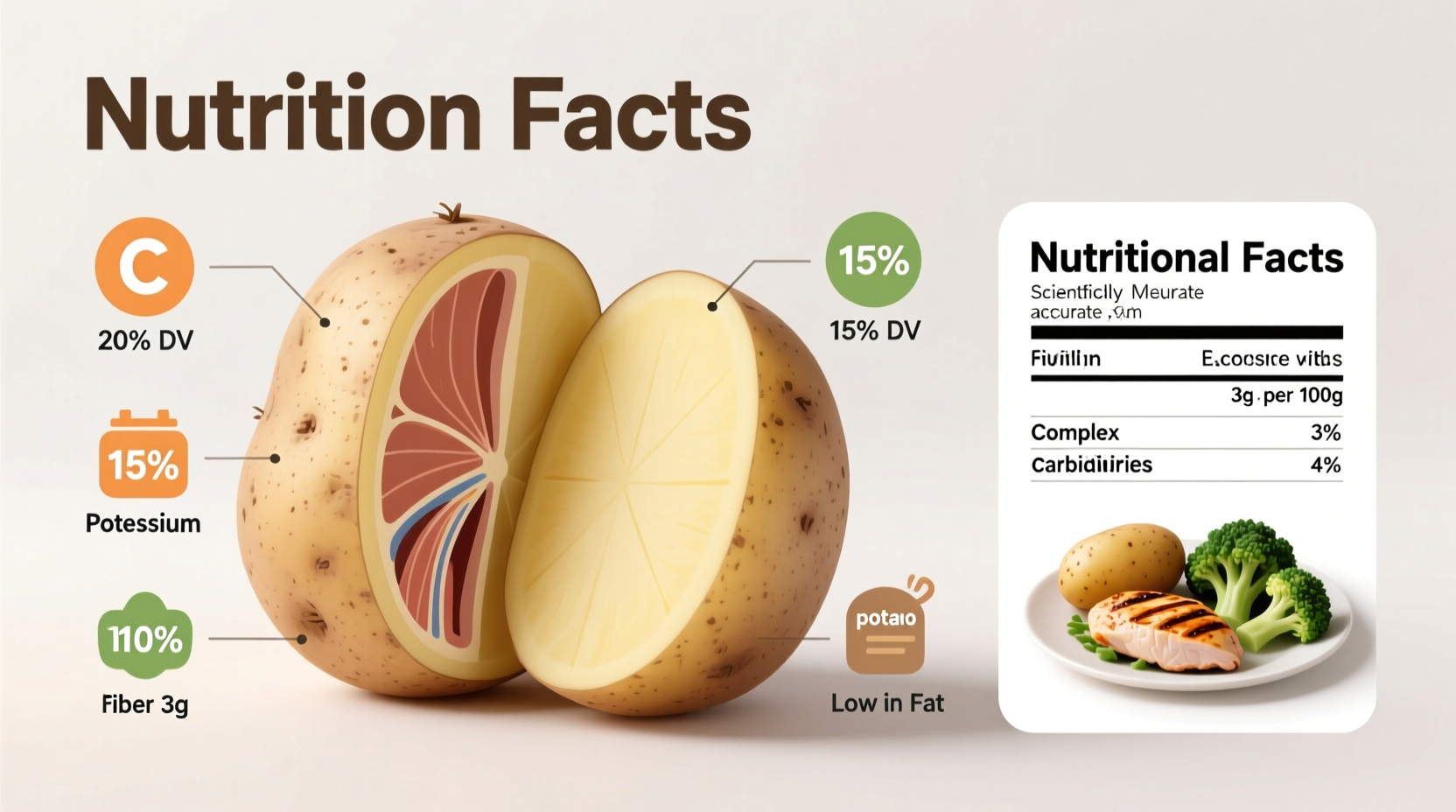Discover exactly what makes potatoes a nutritional powerhouse beyond their carbohydrate reputation. This comprehensive guide reveals science-backed facts about potato nutrition that most people miss, including how preparation methods dramatically impact nutrient retention and which varieties offer the highest antioxidant levels. You'll learn why potatoes deserve a regular place in balanced diets and how to maximize their health benefits through smart cooking techniques.
Complete Nutritional Profile of Potatoes
When evaluating what is the nutrition of potato, it's essential to examine both macronutrients and micronutrients. A medium-sized potato (150g) with skin provides:
| Nutrient | Amount per 150g | % Daily Value |
|---|---|---|
| Calories | 115 | 6% |
| Carbohydrates | 26g | 9% |
| Dietary Fiber | 3.3g | 12% |
| Protein | 3g | 6% |
| Potassium | 632mg | 18% |
| Vitamin C | 27mg | 30% |
| Vitamin B6 | 0.4mg | 24% |
| Manganese | 0.3mg | 15% |
Source: USDA FoodData Central (2023)
How Potato Varieties Differ Nutritionally
Not all potatoes offer identical nutritional profiles. Understanding potato nutritional value per 100g across varieties helps you make informed dietary choices:
| Potato Variety | Calories | Fiber (g) | Vitamin C (mg) | Antioxidant Activity |
|---|---|---|---|---|
| Russet | 79 | 2.1 | 9.5 | Moderate |
| Red | 70 | 2.2 | 10.5 | High |
| Sweet Potato | 86 | 3.0 | 12.8 | Very High |
| Purple/Blue | 77 | 2.3 | 11.2 | Exceptional |
The vibrant pigments in colored potatoes indicate higher levels of anthocyanins and other antioxidants. According to research published in the Journal of Agricultural and Food Chemistry, purple potatoes contain up to four times more antioxidants than white varieties. This makes them particularly valuable for anti-inflammatory benefits of potatoes in diet.
Maximizing Nutrient Retention During Cooking

Your cooking method significantly impacts the final nutritional value. Boiling potatoes with skin intact preserves up to 80% of vitamin C, while peeling before boiling can reduce vitamin C content by 30-50%. The National Potato Council's research shows that microwaving retains the highest overall nutrient profile, followed by baking.
When exploring best way to cook potatoes to retain nutrients, consider these evidence-based recommendations:
- Always cook with skin on - the skin contains up to 50% of the fiber and significant nutrient concentrations
- Avoid overcooking - prolonged high heat degrades heat-sensitive vitamins like vitamin C
- Cool cooked potatoes before eating - creates resistant starch that functions like fiber
- Pair with healthy fats - enhances absorption of fat-soluble nutrients
Addressing Common Potato Nutrition Misconceptions
Many people wonder are potatoes healthy for weight loss despite their carbohydrate content. The truth is potatoes have a high satiety index - ranking higher than pasta, rice, or even oats. A study from the University of Sydney found boiled potatoes were 300% more filling than white bread per calorie.
Regarding potassium content in potatoes vs bananas, a medium potato actually contains more potassium (632mg) than a medium banana (422mg). This makes potatoes an excellent choice for maintaining healthy blood pressure levels, as recognized by the American Heart Association's dietary guidelines.
Practical Applications for Daily Nutrition
Understanding vitamins in potatoes with skin helps you incorporate them strategically into meals. For optimal blood sugar management, pair potatoes with protein and healthy fats. The resistant starch formed when cooled potatoes makes them particularly valuable for gut health.
Nutritionists recommend including potatoes 2-3 times weekly as part of a balanced diet. For those monitoring carbohydrate intake, substituting one serving of refined grains with potatoes provides significantly more fiber, vitamins, and minerals.
Frequently Asked Questions
Are potatoes healthy when eaten with the skin?
Yes, eating potatoes with skin significantly increases fiber content and preserves nutrients concentrated near the surface. The skin contains up to 50% of the potato's total dietary fiber and substantial amounts of vitamins and minerals. Just ensure thorough washing to remove any surface contaminants.
How does potato nutrition compare to other staple foods?
Potatoes provide more potassium than bananas, more vitamin C than tomatoes, and comparable protein to rice by weight. They offer a more balanced nutrient profile than refined grains, with higher fiber content when consumed with skin. Unlike many grains, potatoes are naturally gluten-free.
Do potatoes lose nutrients when cooked?
Some nutrient loss occurs with cooking, particularly water-soluble vitamins like vitamin C. However, proper cooking methods minimize this loss. Boiling with skin intact preserves up to 80% of vitamin C, while microwaving retains the highest overall nutrient profile. The formation of resistant starch when cooled provides additional health benefits not present in raw potatoes.
Can potatoes be part of a weight management diet?
Yes, potatoes have a high satiety index, meaning they help you feel full longer per calorie consumed. Research shows boiled potatoes are 300% more filling than white bread. For weight management, focus on preparation methods (baking or boiling instead of frying) and portion sizes, and pair with protein and vegetables for balanced meals.











 浙公网安备
33010002000092号
浙公网安备
33010002000092号 浙B2-20120091-4
浙B2-20120091-4